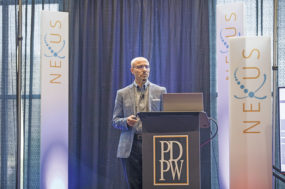Nutritionist Tim Thompson has been balancing rations for dairy clients in the Midwest for 24 years.
This year he says is exceptional, but not in a good way.“This has been the toughest downturn I’ve gone through,” Thompson says.
A milk-feed ratio at its lowest point ever and high overhead production costs have made turning a profit from milk production a “very difficult situation” for any producer, he says. However, Thompson is using his company’s unique feed ration balancing program to help his clients match their forage and carbohydrate sources with the best-use, least-cost protein sources available. This, he says, helps make ration balancing more accurate and economical.
“We are able to maximize the ration to lower crude protein,” Thompson says. “A lot of our diets for high-producing cows are either at or below 17 percent and every once in a while below 16 percent crude.”
Thompson says that much of what is driving how feed impacts the milk-to-feed price ratio is an increase in prices for protein sources. One of his main concerns is where protein prices will go in the next few months. He says precision in feeding protein is one way producers could save ration cost.
“Feeding extra protein is money wasted,” Thompson says.
Thompson uses his company’s Amino Acid Metabolizable Protein (AAMPS) ration balancing system. The program uses ingredient nutrients to build a mathematical model of how a ration will be digested in the rumen.
“Forages are the cheap part of the ration, especially in this economic climate,” says Mark Hill, a ruminant nutritionist at the Akey Research and Nutrition Center. “So we try to maximize the use of forages. AAMPS is used to match the energy that is being fermented in the rumen from the forages and other feeds with the appropriate amount of rumen-degraded protein and peptides.”
The program has direct inputs for neutral detergent fiber digestibility (NDFd) (taking into account adjustments for 24-, 36- or 48-hour tests), micron size and moisture content and degree of kernel processing for corn in corn silage, high-moisture corn and dry corn.
“More than 20 years ago we talked about balancing for crude protein and TDN. But today we can get all sorts of information from our laboratories, tests that didn’t even exist 25 years ago,” Hill says.
One such test that the program can incorporate is the prolamine content of corn. The test should be made commercially available by the end of the year at major forage testing labs and is based on recently released research by Pat Hoffman at the University of Wisconsin-Marshfield Research Station. Hoffman showed that the degradation of corn in the rumen is related to a plant protein in corn, known as prolamine. The test will help nutritionists estimate how quickly corn will degrade in the rumen, Hill says.
“The program helps choose which proteins are optimum for the carbohydrate and fiber sources we are feeding,” Thompson says.
On one of his client’s dairies in the Midwest (ration featured on page 40), that means optimizing protein to feed a diet high in corn silage and high-moisture ear corn. To save on ration protein cost, Thompson recently removed blood and poultry meal and replaced them with commercially available amino acids and Aalpha Tek, a product that slows the rumen degradability of B-fraction proteins.
“We’re trying to make milk as cheap as possible and agronomic as possible,” Thompson says.
That means feeding a unique form of earlage or high-moisture ear corn, also known as snaplage, which is economical for the producer to grow and ensile.
What is snaplage?
Bill Mahanna, nutritional sciences manager for Pioneer, defines snaplage as high-moisture corn harvested with a forage harvester, consisting of the ear, husk and shank.
“We are talking about going in and harvesting the ear as soon as the kernel hits black layer, which in most hybrids, is somewhere around 35 percent kernel moisture,” Mahanna says. “When you add in the wetter cob, you are talking about a feed that is upwards of 40 percent moisture.”
The product is recommended by many custom forage operators, Mahanna says, because it can be harvested almost immediately following corn silage, and when fitted with a snapper head, it is yet another crop for them to harvest. It also fits nicely into a harvest window between silage and combining dry corn or soybeans. It can be utilized anywhere in the U.S. so long as it is harvested at the right moisture. Many nutritionists are somewhat cautious about snaplage, Mahanna says, especially if they have had to feed snaplage which has been put up too dry, causing difficulty with kernel damage, compaction and feed stability, especially during hot weather. Thompson says ensiling it correctly is essential to avoiding spoilage.
Thompson’s client used a high-moisture corn inoculant (Pioneer brand 11B91) containing several bacterial strains, including an L. buchneri, researched specifically for use on snaplage or high-moisture shelled corn. The dairy feeds about 5 inches off the bunker face per day, and spoiling hasn’t been an issue.
“We walked out to the bunker recently. It was just beautiful feed and wasn’t heating at all,” Mahanna says.
Thompson says he likes the feed because it provides a quickly fermentable starch available to the rumen. It’s also easy on the ration cost.
“It’s a nice least-cost feed to work with,” he says. “The producer is planning to do snaplage again. The economics of it really make sense.”
Recent ration changes
Last fall Thompson’s client switched from feeding one ration to feeding two.
“With the dairy economy the way it’s gone, using a single group ration was driving up feed costs for low-producing cows,” Thompson says.
The level of dextrose fed has also changed. Thompson says the dried corn syrup product was originally included to add more up-front energy to the diet. As the snaplage has aged, he’s decreased the amount of dextrose fed. The dextrose product costs about the same as the price of corn.
Thompson is most proud of this Holstein herd’s feed efficiency, which is 1.695.
“We are able to get quite a lot of milk out of them while keeping them healthy,” Thompson says.
Why protein is so important
A frequent conversation Thompson will have with new clients who are learning about how AAMPS balances rations is why feeds that look good on paper aren’t the best addition once included in the ration. They are the hidden opportunity costs of ration balancing.
“Sometimes producers will look at a protein source and look at the price and want to buy so many tons of it. Per point of protein it may be cheaper than their current proteins, but in some rations the protein source may not work because of its percentage of solubility, degradability and rumen bypass. It may only fit in certain rations. If we were to put it in, we might end up losing milk.”
Eventually Thompson’s producer clients begin to see how not all proteins are the same. Then their rations begin to be truly precise.
“Precision, especially with proteins, is what we are trying to do and that is how you least-cost the ration and least-cost production." PD
Tim Thompson
Nutritionist Akey Feeds
tthompson@akey.com
Walt Cooley
Editor
Progressive Dairyman






